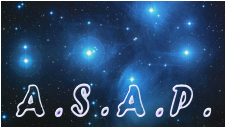
| ||||||||
| roAp | Lambda Bootis | Solar type stars | Doppler Imaging |
Quantitative Spectroscopy of roAp Stars
M. Gelbmann developed and continuously improved the AAP script (Gelbmann 1996) which allows to automatically fit synthetic spectra to observations. Besides the already finished analyses of alpha Cir (Kupka et al. 1996), gamma Equ (Ryabchikova et al. 1997), HD203932 (Gelbmann et al. 1997), HD24712 (Ryabchikova et al. 1997), three further roAp stars (HD137949, HD166473, HD217522) have been investigated up to now.Element abundances were determined with Kurucz model atmospheres scaled to solar abundances. The results were compared with data of normal B and A stars, and two lambda Bootis stars. Up to 42 elements could be identified. This represents the most complete chemical investigation of CP2 stars hitherto carried out which can be summarized as:
all investigated roAp stars have a similar abundance pattern,Besides an unexpected possible relation between effective temperature and metallicity of roAp stars, no outstanding differences to non-pulsating Ap stars could be detected. However, no comparably detailed investigation of non-pulsating Ap stars exist which could confirm this statement.the overabundances of rare earth and other heavy elements are comparable to cool non-pulsating Ap stars,
iron belongs to the most deficient and cobalt to the most enhanced elements of the iron peak group,
the light elements carbon, nitrogen, and oxygen are less abundant than in atmospheres with solar scaled abundances.

Magnetic fields were estimated from profiles of blend free spectral
lines with different Zeeman pattern for almost all roAp stars
investigated in our group so far.
Spectra for additional 4 roAp stars are available and more will be
observed in the coming seasons on the spectroscopic properties of the
group of roAp stars.
Model Atmospheres
Doppler imaging and most of quantitative spectroscopy are based on sets of plane parallel model atmospheres. Local thermal equilibrium and a homogenous chemical composition as well as the application of the mixing length theory to describe stellar convection are standard assumptions made for these classical model atmospheres. The ATLAS9 code by Robert L. Kurucz is the most common program for the computation of classical model atmospheres for mid B to early G type stars and has now been used by our group for several years.
To provide an improved and more realistic basis for spectroscopic work
on Ap stars and a more reliable boundary condition for stellar interiors
and stellar pulsation modelling, classical model atmospheres have to
incorporate many physical effects which have been neglected thus far
to allow for a simple mathematical (and hence computational) treatment.
Work done by F. Kupka to improve model atmospheres focused on two aspects
both of crucial importance for modelling the photosphere of roAp stars.
First, opacities used in the atmosphere computations should be based on the
individual chemical composition of an Ap star as obtained from abundance
analyses. This work, done in collaboration with N.E. Piskunov
(University of Uppsala, Sweden),
resulted in a set of tools to compute opacity distribution functions
with arbitrary chemical compositions and influenced both the creation
and development of the Vienna Atomic Line Data Base (VALD).
Another aspect of improving model atmospheres of roAp stars is the treatment
of stellar convection that is still based on mixing length theory.
The temperature domain of cool roAp stars
includes the region where convection is supposed to become efficient
enough to transport a significant part of the energy flux through at
least the deepest regions of stellar atmospheres. In collaboration
with V.M. Canuto (NASA) the CM formalism was implemented into the ATLAS9
code. Grids of model atmospheres, synthetic fluxes, and colours were
computed subsequently to investigate systematic effects (on colours),
to find regions in the HR diagram where a different treamtent of
convection affects spectroscopy, photometry, or spectrophotometry, and to
study the influence of the CM formalism on the spectroscopic analysis
of roAp stars.
Mode Life Time and Critical Frequencies of roAp Stars
When N. Audard joined the team as Lise Meitner fellow, she started to implement the CM formalism in the CESAM code, constructed by P. Morel in Nice, in close collaboration with F. Kupka who has extensively worked with this description in the ATLAS9 code of stellar atmospheres. It was shown in the solar case that the CM theory gives a steeper temperature gradient below the surface, which leads to theoretical frequencies in better agreement with the observations.With this new description, we intend to compute more reliable stellar models and frequencies. For some roAp stars, frequencies are observed which are larger than the theoretical acoustic cut-off frequency. This frequency depends on the T-Tau relation used in the atmosphere, which might significantly deviate from the relation derived from standard models using the MLT formalism, and for opacities taking the chemical peculiarities of the atmosphere into account. The cut-off frequency derived from CM models will therefore be different from that obtained from standard MLT models. A comparison with observations will provide important indications for which of the models describing convection in stars should be prefered.
In charge of this page is: Friedrich Kupka.